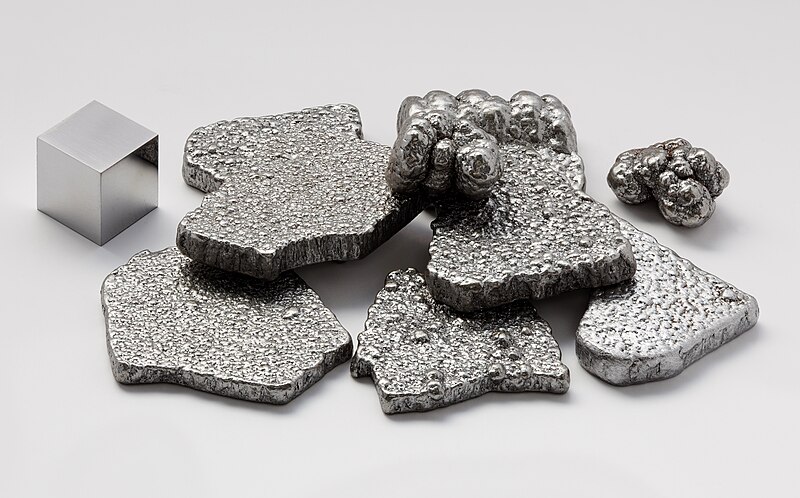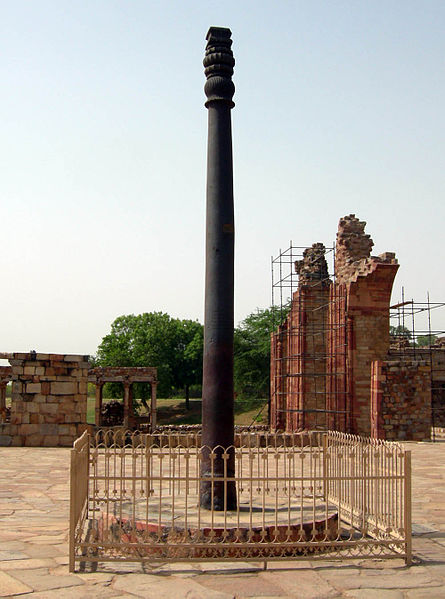 |
| Pure (99.97 %+) iron chips, electrolytically refined and high purity (99.9999 %) 1 cm3 iron cube |
Iron is the second most abundant metal in nature after aluminium. But native iron is extremely rare. Probably, the first iron used by our forefathers was of a meteoritic origin. Iron oxidizes readily in the presence of water and air and is found mainly in the form of oxides. Oxidation of iron is responsible for the fact that extant articles made of iron in antiquity are extremely rare. Man discovered iron about five thousand years ago. At first iron was very expensive and was valued much higher than gold; very often iron jewelry was set in gold.
Peoples of all continents became aware of gold, silver, and copper approximately at the same time; but in the case of iron the situation is different. Thus, in Egypt and Mesopotamia the process of extracting iron from ores was dis-covered two thousand years B.C.; in Trans-Caucasus, Asia Minor, and ancient Greece at the end of the second millennium; in India in the middle of the second millennium; and in China much later, only in the middle of the first millennium B.C. In the countries of the New World Iron Age began only with the arrival of Europeans, i.e. in the second millennium A.D.; some African tribes began to use iron skipping the Bronze Age period in development. This is due to the difference in natural conditions. In countries where natural resources of copper and tin were small, a demand arose for replacing these metals. America had one of the largest deposits of native copper and, therefore, it was not necessary to search for new metals. Gradually, production of iron grew and iron began to pass from the category of precious metals into that of ordinary ones. By the beginning of the Christian era iron was already widely used.
Among all metals and alloys known by that time, iron was the hardest one. Therefore, as soon as iron grew relatively cheap, various tools and weapons were manufactured from it. At the beginning of the first millennium A.D. production of iron in Europe and Asia had made considerable progress; particularly great successes in smelting and processing iron had been achieved by Indian metallurgists.
It is interesting to have a look at the development of iron production methods. At first man used only meteoritic iron, which was very rare and therefore expensive. Then people learnt how to produce iron by intensively heating its ores with coal on windy sites. Iron thus obtained was spongy, of low grade, and with large inclusions of slag. An important step in iron production was made with the invention of a furnace open at the top and lined with a refractory material inside. Excavations of ancient towns in Syria indicate that iron of a rather good quality was produced in this way. Later, people noted that cast iron, which had been considered to be a waste product, could be transformed into iron, the process requiring much less coal and yielding high-quality iron.
 |
| Iron meteorites, similar in composition to the Earth's inner- and outer core |
By the end of the 15th century first smelting furnaces appeared producing exclusively cast iron. Iron and steel smelting processes were rapidly improving. In 1855 there appeared the converter process of steel making which is still used. The Martin process developed in 1865 yields steel almost free of slags.
A chemical symbol Fe originates from the Latin ferrum, which means "iron".
 |
| The iron pillar of Delhi is an example of the iron extraction and processing methodologies of early India |
 |
| A pot of melted iron in the process of steel-production |
Source - Chemical Elements : How They Were Discovered
Read more at the Science Pole App
No comments:
Post a Comment